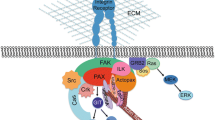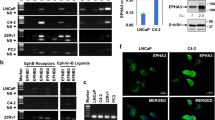Abstract
Cell migration is essential for many physiological and pathological processes, including embryonic development, wound healing, immune response and cancer metastasis. Inka2 transcripts are observed in migrating cells during embryonic development, suggesting the involvement of inka2 in cell migration. However, its precise role remains unclear. Here, we found that inka2 controlled focal adhesion dynamics and cell migration, likely by regulating protein phosphatase-2A (PP2A) function. A scratch assay revealed that inka2 shRNA-transfected NIH3T3 cells showed rapid wound closure, indicating an inhibitory effect by inka2 on cell migration. Live-cell imaging of NIH3T3 cells expressing EGFP-paxillin using total internal reflection fluorescence microscopy revealed that inka2 knockdown increased the turnover rate of focal adhesions. Given that PP2A, which consists of catalytic (C), regulatory (B) and scaffolding (A) subunits, is known to regulate focal adhesions, we examined the inka2-PP2A interaction. Immunoprecipitation revealed an association between inka2 and the PP2A C subunit. Binding of Inka2 to the C subunit prevented the association between the A and C subunits, suggesting that inka2 can inhibit PP2A function. Furthermore, both inka2 expression and PP2A inhibition decreased focal adhesion kinase-paxillin interaction, resulting in reduced formation of focal adhesions. We assessed the effect of pharmacological PP2A inhibition on the inka2 knockdown-induced increase in cell migration speed and found that treatment with a PP2A inhibitor negated the accelerated migration of inka2 knockdown cells. These results suggest that inka2 knockdown exerts its effects through PP2A-dependent regulation of focal adhesions. Our findings contribute to a better understanding of the molecular mechanisms underlying cell migration.






Similar content being viewed by others
References
Arnaud L, Chen S, Liu F, Li B, Khatoon S, Grundke-Iqbal I, Iqbal K (2011) Mechanism of inhibition of PP2A activity and abnormal hyperphosphorylation of tau by I2(PP2A)/SET. FEBS Lett 585:2653–2659
Barber M, Arai Y, Morishita Y, Vigier L, Causeret F, Borello U, Ledonne F, Coppola E, Contremoulins V, Pfrieger FW, Tissir F, Govindan S, Jabaudon D, Proux-Gillardeaux V, Galli T, Pierani A (2015) Migration speed of Cajal-Retzius cells modulated by vesicular trafficking controls the size of higher-order cortical areas. Curr Biol 25:2466–2478
Baskaran R, Velmurugan BK (2018) Protein phosphatase 2A as therapeutic targets in various disease models. Life Sci 210:40–46
Beggs HE, Schahin-Reed D, Zang K, Goebbels S, Nave KA, Gorski J, Jones KR, Sretavan D, Reichardt LF (2003) FAK deficiency in cells contributing to the basal lamina results in cortical abnormalities resembling congenital muscular dystrophies. Neuron 40:501–514
Bellis SL, Miller JT, Turner CE (1995) Characterization of tyrosine phosphorylation of paxillin in vitro by focal adhesion kinase. J Biol Chem 270:17437–17441
Bribian A, Nocentini S, Llorens F, Gil V, Mire E, Reginensi D, Yoshida Y, Mann F, del Rio JA (2014) Sema3E/PlexinD1 regulates the migration of hem-derived Cajal-Retzius cells in developing cerebral cortex. Nat Commun 5:4265
Brown MC, Turner CE (2004) Paxillin: adapting to change. Physiol Rev 84:1315–1339
Chen W, Possemato R, Campbell KT, Plattner CA, Pallas DC, Hahn WC (2004) Identification of specific PP2A complexes involved in human cell transformation. Cancer Cell 5:127–136
Deramaudt TB, Dujardin D, Noulet F, Martin S, Vauchelles R, Takeda K, Ronde P (2014) Altering FAK-paxillin interactions reduces adhesion, migration and invasion processes. PLoS One 9:e92059
Fan L, Liu MH, Guo M, Hu CX, Yan ZW, Chen J, Chen GQ, Huang Y (2016) FAM122A, a new endogenous inhibitor of protein phosphatase 2A. Oncotarget 7:63887–63900
Gardel ML, Schneider IC, Aratyn-Schaus Y, Waterman CM (2010) Mechanical integration of actin and adhesion dynamics in cell migration. Annu Rev Cell Dev Biol 26:315–333
Ghosh I, Hamilton AD, Regan L (2000) Antiparallel leucine zipper-directed protein reassembly: application to the green fluorescent protein. J Am Chem Soc 122:5658–5659
Graus-Porta D, Blaess S, Senften M, Littlewood-Evans A, Damsky C, Huang Z, Orban P, Klein R, Schittny JC, Muller U (2001) Beta1-class integrins regulate the development of laminae and folia in the cerebral and cerebellar cortex. Neuron 31:367–379
Hu Y, Lu J, Xu X, Lyu J, Zhang H (2017) Regulation of focal adhesion turnover in SDF-1alpha-stimulated migration of mesenchymal stem cells in neural differentiation. Sci Rep 7:10013
Ito A, Kataoka TR, Watanabe M, Nishiyama K, Mazaki Y, Sabe H, Kitamura Y, Nojima H (2000) A truncated isoform of the PP2A B56 subunit promotes cell motility through paxillin phosphorylation. EMBO J 19:562–571
Iwasaki Y, Yumoto T, Sakakibara S (2015) Expression profiles of inka2 in the murine nervous system. Gene Expr Patterns 19:83–97
Jackson JL, Young MR (2002) Protein phosphatase-2A modulates the serine and tyrosine phosphorylation of paxillin in Lewis lung carcinoma tumor variants. Clin Exp Metastasis 19:409–415
Janssens V, Zwaenepoel K, Rosse C, Petit MM, Goris J, Parker PJ (2016) PP2A binds to the LIM domains of lipoma-preferred partner through its PR130/B″ subunit to regulate cell adhesion and migration. J Cell Sci 129:1605–1618
Kim E, Ilic N, Shrestha Y, Zou L, Kamburov A, Zhu C, Yang X, Lubonja R, Tran N, Nguyen C, Lawrence MS, Piccioni F, Bagul M, Doench JG, Chouinard CR, Wu X, Hogstrom L, Natoli T, Tamayo P, Horn H, Corsello SM, Lage K, Root DE, Subramanian A, Golub TR, Getz G, Boehm JS, Hahn WC (2016) Systematic functional interrogation of rare acncer variants identifies oncogenic alleles. Cancer Discov 6:714–726
Kuboyama T, Luo X, Park K, Blackmore MG, Tojima T, Tohda C, Bixby JL, Lemmon VP, Kamiguchi H (2013) Paxillin phosphorylation counteracts proteoglycan-mediated inhibition of axon regeneration. Exp Neurol 248:157–169
Liang CC, Park AY, Guan JL (2007) In vitro scratch assay: a convenient and inexpensive method for analysis of cell migration in vitro. Nat Protoc 2:329–333
Luo T, Xu Y, Hoffman TL, Zhang T, Schilling T, Sargent TD (2007) Inca: a novel p21-activated kinase-associated protein required for cranial neural crest development. Development 134:1279–1289
Mitra SK, Hanson DA, Schlaepfer DD (2005) Focal adhesion kinase: in command and control of cell motility. Nat Rev Mol Cell Biol 6:56–68
Nagano M, Hoshino D, Koshikawa N, Akizawa T, Seiki M (2012) Turnover of focal adhesions and cancer cell migration. Int J Cell Biol 2012:310616
Oakes PW (2018) Balancing forces in migration. Curr Opin Cell Biol 54:43–49
Pasapera AM, Schneider IC, Rericha E, Schlaepfer DD, Waterman CM (2010) Myosin II activity regulates vinculin recruitment to focal adhesions through FAK-mediated paxillin phosphorylation. J Cell Biol 188:877–890
Rashid M, Belmont J, Carpenter D, Turner CE, Olson EC (2017) Neural-specific deletion of the focal adhesion adaptor protein paxillin slows migration speed and delays cortical layer formation. Development 144:4002–4014
Reid BS, Sargent TD, Williams T (2010) Generation and characterization of a novel neural crest marker allele, Inka1-LacZ, reveals a role for Inka1 in mouse neural tube closure. Dev Dyn 239:1188–1196
Schaller MD, Otey CA, Hildebrand JD, Parsons JT (1995) Focal adhesion kinase and paxillin bind to peptides mimicking beta integrin cytoplasmic domains. J Cell Biol 130:1181–1187
Slupe AM, Merrill RA, Strack S (2011) Determinants for substrate specificity of protein phosphatase 2A. Enzyme Res 2011:398751
Strack S, Cribbs JT, Gomez L (2004) Critical role for protein phosphatase 2A heterotrimers in mammalian cell survival. J Biol Chem 279:47732–47739
Tian L, Zhang XG, Haesen D, Bravo J, Fominaya J, Choquet S, Zini JM, Loisel S, Waelkens E, Janssens V, Rebollo A (2018) Identification of PP2A/set binding sites and design of interacting peptides with potential clinical applications. Int J Pept Res Ther 24:479–488
Valiente M, Ciceri G, Rico B, Marin O (2011) Focal adhesion kinase modulates radial glia-dependent neuronal migration through connexin-26. J Neurosci 31:11678–11691
Villar-Cervino V, Molano-Mazon M, Catchpole T, Valdeolmillos M, Henkemeyer M, Martinez LM, Borrell V, Marin O (2013) Contact repulsion controls the dispersion and final distribution of Cajal-Retzius cells. Neuron 77:457–471
Vomastek T, Iwanicki MP, Schaeffer HJ, Tarcsafalvi A, Parsons JT, Weber MJ (2007) RACK1 targets the extracellular signal-regulated kinase/mitogen-activated protein kinase pathway to link integrin engagement with focal adhesion disassembly and cell motility. Mol Cell Biol 27:8296–8305
Webb DJ, Donais K, Whitmore LA, Thomas SM, Turner CE, Parsons JT, Horwitz AF (2004) FAK-Src signalling through paxillin, ERK and MLCK regulates adhesion disassembly. Nat Cell Biol 6:154–161
Wlodarchak N, Xing Y (2016) PP2A as a master regulator of the cell cycle. Crit Rev Biochem Mol Biol 51:162–184
Young MR, Liu SW, Meisinger J (2003) Protein phosphatase-2A restricts migration of Lewis lung carcinoma cells by modulating the phosphorylation of focal adhesion proteins. Int J Cancer 103:38–44
Yumoto T, Nakadate K, Nakamura Y, Sugitani Y, Sugitani-Yoshida R, Ueda S, Sakakibara S (2013) Radmis, a novel mitotic spindle protein that functions in cell division of neural progenitors. PLoS One 8:e79895
Zaidel-Bar R, Milo R, Kam Z, Geiger B (2007) A paxillin tyrosine phosphorylation switch regulates the assembly and form of cell-matrix adhesions. J Cell Sci 120:137–148
Acknowledgments
We are grateful to Prof. W. Hahn for providing plasmids, DONR223_PPP2R1A_WT and pBABE zeo PPP2CA Wt, obtained from Addgene. We thank Dr. T. Hida, Ms. R. Shigematsu, and Ms. A. Tanaka for their technical assistance.
We would like to thank Editage (www.editage.jp) for English language editing.
Funding
This work was supported by JSPS KAKENHI grant numbers 16 K14583, 18 K06491 (to H.A.) and 26430042 (to S.S.) and by Waseda University Grants for Special Research Projects 2018 K-352 (to H.A.), 2015 K-249 and 2017 K-301 (to S.S.).
Author information
Authors and Affiliations
Corresponding authors
Ethics declarations
Conflict of interest
The authors declare that they have no conflicts of interest with the contents of this article.
Ethical approval
All experiments in this study were approved by the Committee on the Ethics of Animal Experiments of Waseda University.
Additional information
Publisher’s note
Springer Nature remains neutral with regard to jurisdictional claims in published maps and institutional affiliations.
Rights and permissions
About this article
Cite this article
Akiyama, H., Iwasaki, Y., Yamada, S. et al. Control of cell migration by the novel protein phosphatase-2A interacting protein inka2. Cell Tissue Res 380, 527–537 (2020). https://doi.org/10.1007/s00441-020-03169-x
Received:
Accepted:
Published:
Issue Date:
DOI: https://doi.org/10.1007/s00441-020-03169-x




